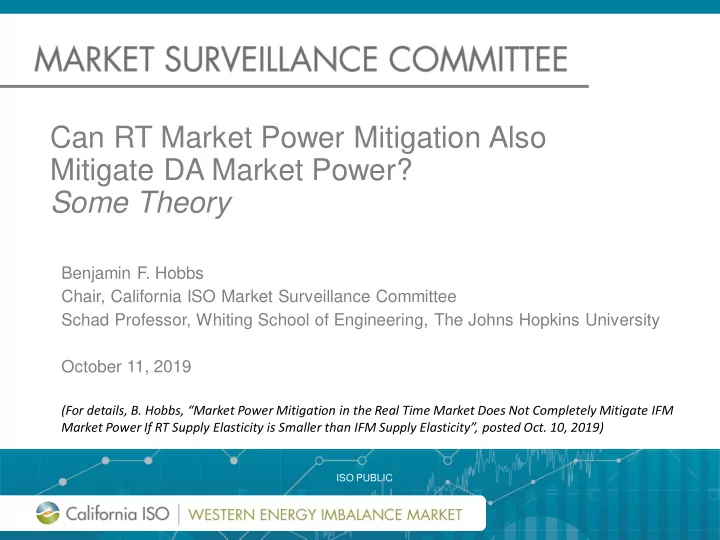

Can RT Market Power Mitigation Also Mitigate DA Market Power? Some Theory Benjamin F. Hobbs Chair, California ISO Market Surveillance Committee Schad Professor, Whiting School of Engineering, The Johns Hopkins University October 11, 2019 (For details, B. Hobbs, “Market Power Mitigation in the Real Time Market Does Not Completely Mitigate IFM Market Power If RT Supply Elasticity is Smaller than IFM Supply Elasticity”, posted Oct. 10, 2019) ISO PUBLIC ISO PUBLIC
Summary of results • Assumptions: • Perfect RT market power mitigation (offers = marginal cost) • Perfect virtual bidding • Linear supply & demand • Oligopolistic suppliers compete a la Cournot (choose own output, assuming other suppliers and virtual bidders won’t change theirs) • Suppliers optimize in each market as if it is a standalone market (i.e., a supplier who sells more DA doesn’t consider that its marginal cost in RT will increase) • RUC doesn’t impact RT market prices • No uncertainty • Results • It could work! Mitigating RT market power alone will fully mitigate DA market power, if supply in both markets is equally elastic • But virtual bidding is not necessarily enough! If RT supply is less elastic than DA supply, RT mitigation will only partially mitigate DA market power • DA supply restriction results in VB shifting load to RT, when supply is more costly ISO PUBLIC 2
Model Supply: Demand: $/MWh $/MWh RT MC IFM MC RT Demand IFM Demand d 1 = MW MW g 1 = 34.5 22.2 Here, supply and demand are both less elastic in RT than in DA Note that RT supply starts from the point on the IFM supply curve corresponding to g 1 . Similarly, RT demand starts from the point on the IFM demand curve corresponding to d 1 . RT lines are steeper in both cases. 3 ISO PUBLIC
Model Solution: Monopolist Mitigated in RT • Solve for 5 variables (supply & demand in each market, virtual supply) using 5 equations (first-order profit max conditions & market clearing in each market, no-arbitrage condition). Result: RT MC $/MWh IFM MC P=65.5, Monopoly Solution with RT mitigation vs 1 =g 2 RT Demand =12.3 IFM Demand MW g 1 = d 1 = 100 22.2 34.5 ISO PUBLIC 4
Comparison with Competitive Solution • Thus, some market power exercised • Less load served • Higher costs (due to supply provided in RT rather than DA) RT MC $/MWh IFM MC Competitive solution= P=65.5, crossing of IFM Monopoly demand & IFM MC, Solution with RT P = $64, d 1 = 36 mitigation vs 1 =g 2 RT Demand =12.3 IFM Demand MW g 1 = d 1 = 100 22.2 34.5 ISO PUBLIC 5
Comparison with Unmitigated Monopolist Case • Thus, most of market power mitigated here, as mitigated prices and quantities are closer to competitive case than unmitigated case RT MC $/MWh IFM MC Unmitigated P=65.5, Monopoly, Monopoly P = $73.2, d 1 = 24.3 Solution with RT mitigation vs 1 =g 2 RT Demand =12.3 IFM Demand MW g 1 = d 1 = 100 22.2 34.5 ISO PUBLIC 6
Additional Results (See Posted Paper: B. Hobbs, “Market Power Mitigation in the Real Time Market Does Not Completely Mitigate IFM Market Power If RT Supply Elasticity is Smaller than IFM Supply Elasticity”, Oct. 10, 2019) • RT demand elasticities don’t affect solution (given no uncertainty) • Oligopoly (n=2 or more firms). Again: • Same supply elasticity in RT and DA RT mitigation works perfectly (given other assumptions). The percentage effect on price-cost mark-ups are roughly the same • Less elastic supply in RT mitigation imperfect (but eliminates most market power in cases considered), to extent that elasticities diverge • If suppliers optimize DA supply, recognizing its effect on RT costs, then market power increases • (Conjectured): If RUC increases elasticity of RT supply, then DA mitigation more effective. But if RUC commits wrong units, then costs increase ISO PUBLIC 7
Recommend
More recommend